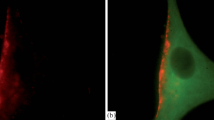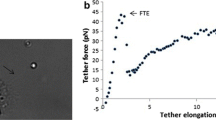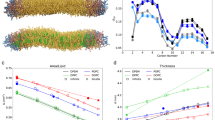Abstract
Cellular cholesterol is a critical component of the plasma membrane, and plays a key role in determining the physical properties of the lipid bilayer, such as elasticity, viscosity, and permeability. Surprisingly, it has been shown that cholesterol depletion increases cell stiffness, not due to plasma membrane stiffening, but rather, due to the interaction between the actin cytoskeleton and the plasma membrane. This indicates that traction stresses of the acto-myosin complex likely increase during cholesterol depletion. Here we use force traction microscopy to quantify the forces individual cells are exerting on the substrate, and total internal reflection fluorescence microscopy as well as interference reflection microscopy to observe cell–substrate adhesion and spreading. We show that single cells depleted of cholesterol produce larger traction forces and have large focal adhesions compared to untreated or cholesterol-enriched cells. Cholesterol depletion also causes a decrease in adhesion area for both single cells and monolayers. Spreading experiments illustrate a decrease in spreading area for cholesterol-depleted cells, and no effect on cholesterol-enriched cells. These results demonstrate that cholesterol plays an important role in controlling and regulating the cell–substrate interactions through the actin–plasma membrane complex, cell–cell adhesion, and spreading.





Similar content being viewed by others
References
Axelrod, D. Total internal reflection fluorescence microscopy in cell biology. Methods Enzymol. 361:1–33, 2003.
Balaban, N. Q., U. S. Schwarz, D. Riveline, P. Goichberg, G. Tzur, et al. Force and focal adhesion assembly: a close relationship studied using elastic micropatterned substrates. Nat. Cell Biol. 3:466–472, 2001.
Bershadsky, A. D., N. Q. Balaban, and B. Geiger. Adhesion-dependent cell mechanosensitivity. Annu. Rev. Cell Dev. Biol. 19:677–695, 2003.
Butler, J. P., I. M. Tolic-Norrelykke, B. Fabry, and J. J. Fredberg. Traction fields, moments, and strain energy that cells exert on their surroundings. Am. J. Physiol. Cell Physiol. 282:C595–C605, 2002.
Byfield, F. J., H. Aranda-Espinoza, V. G. Romanenko, G. H. Rothblat, and I. Levitan. Cholesterol depletion increases membrane stiffness of aortic endothelial cells. Biophys. J. 87:3336–3343, 2004.
Byfield, F. J., S. Tikku, G. H. Rothblat, K. J. Gooch, and I. Levitan. OxLDL increases endothelial stiffness, force generation, and network formation. J. Lipid Res. 47:715–723, 2006.
Cavalli, V., M. Corti, and J. Gruenberg. Endocytosis and signaling cascades: a close encounter. FEBS Lett. 498:190–196, 2001.
Chen, M., R. P. Mason, and T. N. Tulenko. Atherosclerosis alters the composition, structure and function of arterial smooth-muscle cell plasma-membranes. Biochim. Biophys. Acta 1272:101–112, 1995.
Chintagari, N. R., N. Jin, P. Wang, T. A. Narasaraju, J. Chen, and L. Liu. Effect of cholesterol depletion on exocytosis of alveolar type II cells. Am. J. Respir. Cell Mol. Biol. 34:677–687, 2006.
Christian, A. E., M. P. Haynes, M. C. Phillips, and G. H. Rothblat. Use of cyclodextrins for manipulating cellular cholesterol content. J. Lipid Res. 38:2264–2272, 1997.
Corvera, S., C. DiBonaventura, and H. S. Shpetner. Cell confluence-dependent remodeling of endothelial membranes mediated by cholesterol. J. Biol. Chem. 275:31414–31421, 2000.
Curtis, A. S. G. Mechanism of adhesion of cells to glass—study by interference reflection microscopy. J. Cell Biol. 20:199, 1964.
Dembo, M., and Y. L. Wang. Stresses at the cell-to-substrate interface during locomotion of fibroblasts. Biophys. J. 76:2307–2316, 1999.
Dubin-Thaler, B. J., G. Giannone, H. G. Dobereiner, and M. P. Sheetz. Nanometer analysis of cell spreading on matrix-coated surfaces reveals two distinct cell states and STEPs. Biophys. J. 86:1794–1806, 2004.
Engler, A., L. Bacakova, C. Newman, A. Hategan, M. Griffin, and D. Discher. Substrate compliance versus ligand density in cell on gel responses. Biophys. J. 86:617–628, 2004.
Galbraith, C. G., and M. P. Sheetz. A micromachined device provides a new bend on fibroblast traction forces. Proc. Natl Acad. Sci. USA 94:9114–9118, 1997.
Gauthier, N. C., O. M. Rossier, A. Mathur, J. C. Hone, and M. P. Sheetz. Plasma membrane area increases with spread area by exocytosis of a GPI-anchored protein compartment. Mol. Biol. Cell 20:3261–3272, 2009.
Guo, W. H., M. T. Frey, N. A. Burnham, and Y. L. Wang. Substrate rigidity regulates the formation and maintenance of tissues. Biophys. J. 90:2213–2220, 2006.
Ilangumaran, S., and D. C. Hoessli. Effects of cholesterol depletion by cyclodextrin on the sphingolipid microdomains of the plasma membrane. Biochem. J. 335:433–440, 1998.
Joos, U., T. Biskup, O. Ernst, I. Westphal, C. Gherasim, et al. Investigation of cell adhesion to structured surfaces using total internal reflection fluorescence and confocal laser scanning microscopy. Eur. J. Cell Biol. 85:225–228, 2006.
Klausen, T. K., C. Hougaard, E. K. Hoffmann, and S. F. Pedersen. Cholesterol modulates the volume-regulated anion current in Ehrlich-Lettre ascites cells via effects on Rho and F-actin. Am. J. Physiol. Cell Physiol. 291:C757–C771, 2006.
Kong, H. J., T. R. Polte, E. Alsberg, and D. J. Mooney. FRET measurements of cell-traction forces and nano-scale clustering of adhesion ligands varied by substrate stiffness. Proc. Natl Acad. Sci. USA 102:4300–4305, 2005.
Kowalsky, G. B., F. J. Byfield, and I. Levitan. oxLDL facilitates flow-induced realignment of aortic endothelial cells. Am. J. Physiol. Cell Physiol. 295:C332–C340, 2008.
Kwik, J., S. Boyle, D. Fooksman, L. Margolis, M. P. Sheetz, and M. Edidin. Membrane cholesterol, lateral mobility, and the phosphatidylinositol 4,5-bisphosphate-dependent organization of cell actin. Proc. Natl Acad. Sci. USA 100:13964–13969, 2003.
Levitan, I., A. E. Christian, T. N. Tulenko, and G. H. Rothblat. Membrane cholesterol content modulates activation of volume-regulated anion current in bovine endothelial cells. J. Gen. Physiol. 115:405–416, 2000.
Levitan, I., and K. J. Gooch. Lipid rafts in membrane–cytoskeleton interactions and control of cellular biomechanics: actions of oxLDL. Antioxid. Redox Signal. 9:1519–1534, 2007.
Lundbaek, J. A., P. Birn, J. Girshman, A. J. Hansen, and O. S. Andersen. Membrane stiffness and channel function. Biochemistry 35:3825–3830, 1996.
Maxfield, F. R., and I. Tabas. Role of cholesterol and lipid organization in disease. Nature 438:612–621, 2005.
Michiels, C. Endothelial cell functions. J. Cell. Physiol. 196:430–443, 2003.
Needham, D., and R. S. Nunn. Elastic-deformation and failure of lipid bilayer-membranes containing cholesterol. Biophys. J. 58:997–1009, 1990.
Pourati, J., A. Maniotis, D. Spiegel, J. L. Schaffer, J. P. Butler, et al. Is cytoskeletal tension a major determinant of cell deformability in adherent endothelial cells? Am. J. Physiol. Cell Physiol. 43:C1283–C1289, 1998.
Ramprasad, O. G., G. Srinivas, K. S. Rao, P. Joshi, J. P. Thiery, et al. Changes in cholesterol levels in the plasma membrane modulate cell signaling and regulate cell adhesion and migration on fibronectin. Cell Motil. Cytoskeleton 64:199–216, 2007.
Raucher, D., and M. P. Sheetz. Cell spreading and lamellipodial extension rate is regulated by membrane tension. J. Cell Biol. 148:127–136, 2000.
Reinhart-King, C. A., M. Dembo, and D. A. Hammer. Endothelial cell traction forces on RGD-derivatized polyacrylamide substrata. Langmuir 19:1573–1579, 2003.
Riveline, D., E. Zamir, N. Q. Balaban, U. S. Schwarz, T. Ishizaki, et al. Focal contacts as mechanosensors: Externally applied local mechanical force induces growth of focal contacts by an mDia1-dependent and ROCK-independent mechanism. J. Cell Biol. 153:1175–1185, 2001.
Romanenko, V. G., G. H. Rothblat, and I. Levitan. Modulation of endothelial inward-rectifier K+ current by optical isomers of cholesterol. Biophys. J. 83:3211–3222, 2002.
Romanenko, V. G., G. H. Rothblat, and I. Levitan. Sensitivity of volume-regulated anion current to cholesterol structural analogues. J. Gen. Physiol. 123:77–87, 2004.
Saez, A., A. Buguin, P. Silberzan, and B. Ladoux. Is the mechanical activity of epithelial cells controlled by deformations or forces? Biophys. J. 89:L52–L54, 2005.
Sato, M., D. P. Theret, L. T. Wheeler, N. Ohshima, and R. M. Nerem. Application of the micropipette technique to the measurement of cultured porcine aortic endothelial-cell viscoelastic properties. J. Biomech. Eng. 112:263–268, 1990.
Schwarz, U. S., N. Q. Balaban, D. Riveline, A. Bershadsky, B. Geiger, and S. A. Safran. Calculation of forces at focal adhesions from elastic substrate data: the effect of localized force and the need for regularization. Biophys. J. 83:1380–1394, 2002.
Sengupta, K., H. Aranda-Espinoza, L. Smith, P. Janmey, and D. Hammer. Spreading of neutrophils: from activation to migration. Biophys. J. 91:4638–4648, 2006.
Sheetz, M. P., J. E. Sable, and H. G. Dobereiner. Continuous membrane–cytoskeleton adhesion requires continuous accommodation to lipid and cytoskeleton dynamics. Annu. Rev. Biophys. Biomol. Struct. 35:417–434, 2006.
Shibamoto, S., M. Hayakawa, K. Takeuchi, T. Hori, N. Oku, et al. Tyrosine phosphorylation of beta-catenin and plakoglobin enhanced by hepatocyte growth-factor and epidermal growth-factor in human carcinoma-cells. Cell Adhes. Commun. 1:295–305, 1994.
Smith, L. A., H. Aranda-Espinoza, J. B. Haun, M. Dembo, and D. A. Hammer. Neutrophil traction stresses are concentrated in the uropod during migration. Biophys. J. 92:L58–L60, 2007.
Solon, J., I. Levental, K. Sengupta, P. C. Georges, and P. A. Janmey. Fibroblast adaptation and stiffness matching to soft elastic substrates. Biophys. J. 93:4453–4461, 2007.
Sun, M., N. Northup, F. Marga, T. Huber, F. J. Byfield, et al. The effect of cellular cholesterol on membrane–cytoskeleton adhesion. J. Cell Sci. 120:2223–2231, 2007.
Tan, J. L., J. Tien, D. M. Pirone, D. S. Gray, K. Bhadriraju, and C. S. Chen. Cells lying on a bed of microneedles: an approach to isolate mechanical force. Proc. Natl Acad. Sci. USA 100:1484–1489, 2003.
Ukropec, J. A., M. K. Hollinger, S. M. Salva, and M. J. Woolkalis. SHP2 association with VE-cadherin complexes in human endothelial cells is regulated by thrombin. J. Biol. Chem. 275:5983–5986, 2000.
Wang, Y. L., and R. J. Pelham. Preparation of a flexible, porous polyacrylamide substrate for mechanical studies of culture cells. Methods Enzymol. 298:489–496, 1998.
Yeung, T., P. C. Georges, L. A. Flanagan, B. Marg, M. Ortiz, et al. Effects of substrate stiffness on cell morphology, cytoskeletal structure, and adhesion. Cell Motil. Cytoskeleton 60:24–34, 2005.
Acknowledgments
The authors thank Elena Tous for assistance with monolayer staining and preparations. This work was supported by NSF Grant CMMI-0643783 to HAE, National Institutes of Health Grants HL083298 and HL073965 to IL, and a Department of Defense CREST Graduate Fellowship to LLN.
Author information
Authors and Affiliations
Corresponding author
Additional information
Associate Editor Yu-Li Wang oversaw the review of this article.
Rights and permissions
About this article
Cite this article
Norman, L.L., Oetama, R.J., Dembo, M. et al. Modification of Cellular Cholesterol Content Affects Traction Force, Adhesion and Cell Spreading. Cel. Mol. Bioeng. 3, 151–162 (2010). https://doi.org/10.1007/s12195-010-0119-x
Received:
Accepted:
Published:
Issue Date:
DOI: https://doi.org/10.1007/s12195-010-0119-x




